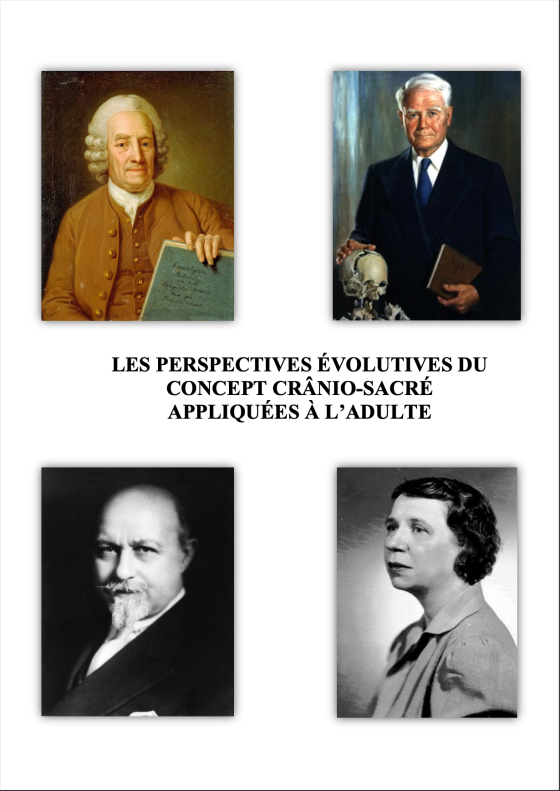
THOMAS Jérémy - Les perspectives évolutives du concept crânio-sacré appliquées à l’adulte. :
Maître de mémoire : ALU Lauris, Ostéopathe D.O.
Mémoire soutenu le 24 juin 2021.
Inscrit au Prix Axitlas 2023

RÉSUMÉ
La pratique de l’ostéopathie crânienne est actuellement un sujet très controversé. Nous nous sommes intéressés à ses origines et aux influences qu’a pu subir son fondateur, William Garner Sutherland. Les avancées scientifiques du XXIème siècle et l’Evidence Based Medicine (EBM) fournissent plusieurs arguments allant à l’encontre des principes du Mécanisme Respiratoire Primaire (MRP), élément central de l’ostéopathie crânienne. Ces données nous ont permis de nous interroger sur la nécessité d’adopter un modèle crânien en ostéopathie. En creusant dans l’histoire de son élaboration, il s’avère que la majorité des composantes du MRP ont été décrites par Emanuel Swedenborg au XVIIIème siècle, que plusieurs notions vitalistes de l’ostéopathie crânienne sont retrouvées dans les écrits de Walter Russell et qu’à la même époque que Sutherland, Charlotte Weaver creusait déjà la question de l’ostéopathie appliquée à la région crânienne.
L’approche crânienne de l’ostéopathie telle qu’elle est enseignée dans les écoles de formation est si différente de celle du reste du corps qu’elle apparaît comme une « autre » ostéopathie. Proposer une pratique applicable au corps entier et appuyée par des arguments scientifiques permettrait à l’ostéopathie crânienne d’être plus opposable et cohérente.
| MOTS-CLÉS : Ostéopathie crânienne, MRP, Histoire de l’ostéopathie, W. Sutherland, E. Swedenborg, W. Russell, C. Weaver. |

ABSTRACT
The practice of cranial osteopathy is currently a very controversial subject. The main goal of this study is to explore the origins of cranial osteopathy and the extent of external influences on its founder, William Garnar Sutherland. The scientific progress of the 21st century and Evidence Based Medicine (EBM) provide several arguments against the principles of Primary Respiratory Mechanism (PRM), the central element of cranial osteopathy. This debate has led us to question the need to adopt a cranial model in osteopathy. Digging into the history of its development, it turns out that Emanuel Swedenborg described most of the components of PRM in the 18th century, that several vitalist notions of cranial osteopathy are found in the writings of Walter Russell, and that at the same time as Sutherland, Charlotte Weaver was already delving into the question of osteopathy applied to the cranial region.
The cranial approach to osteopathy as taught in training schools is so different from that of the rest of the body that it appears as "another" osteopathy. Proposing a practice applicable to the whole body and supported by scientific arguments would allow cranial osteopathy to be more opposable and coherent.
| KEYWORDS : Cranial osteopathy, PRM, History of osteopathy, W. Sutherland, E. Swedenborg, W. Russell, C. Weaver. |
SOMMAIRE
REMERCIEMENTS
RESUME
ABSTRACT
SOMMAIRE
INTRODUCTION
- I. LES ORIGINES ET FONDEMENTS DU CONCEPT CRÂNIO-SACRÉ EN OSTÉOPATHIE
- A. RAPPELS ANATOMO-PHYSIOLOGIQUES DU CRÂNE
- 1. Les os du crâne et leurs articulations
- 2. Les méninges
- 3. Le liquide céphalo-rachidien (LCR)
- B. LE CONCEPT CRANIO-SACRÉ DE SUTHERLAND
- 1. Le mécanisme respiratoire primaire (MRP)
- 2. Le Souffle de Vie – puissance vitale
- 3. Le Fulcrum de Sutherland
- 4. La synchondrose sphéno-basilaire (SSB)
- C. LES THÉORIES EXPLICATIVES DU MRP
- 1. Théorie vasculaire
- 2. Théorie tissulaire ou modèle biochimique de la micro-cinétique
- 3. Théories des fluctuations du LCR (théorie des pressions)
- 4. Théorie des cellules gliales
- A. RAPPELS ANATOMO-PHYSIOLOGIQUES DU CRÂNE
- II. CONNEXIONS HISTORIQUES ET PERSONNALITÉS AYANT INFLUENCÉES W.G
- SUTHERLAND DANS L’ÉLABORATION DU CONCEPT CRANIO-SACRÉ
- A. EMANUEL SWEDENBORG (1688-1772)
- 1. Brève biographie
- 2. Traductions des écrits de Swedenborg
- 3. Comparaisons d’éléments retrouvés dans The Brain
- 4. Ida Rolf (1896-1979)
- 5. Citations de Sutherland concernant Swedenborg
- B. WALTER RUSSEL (1871-1963)
- 1. Brève biographie
- 2. La philosophie russellienne et l’ostéopathie
- 3. L’échange rythmique équilibré
- 4. Influence de la pensée de Russell sur le caractère biodynamique de l’ostéopathie de Sutherland
- 5. Les liens unissant les deux hommes
- C. CHARLOTTE WEAVER (1884-1964)
- 1. Brève biographie
- 2. Une théorie crânienne différente
- 3. Une filiation avec Sutherland
- A. EMANUEL SWEDENBORG (1688-1772)
- III. UN ABORD SCIENTIFIQUE DE L’OSTÉOPATHIE CRÂNIENNE
- A. Ordres de grandeurs des pressions (contraintes)
- B. L’ossification des sutures
- 1. Ossification de la base du crâne
- 2. Ossification de la voûte
- C. Le rôle primordial de l’action des muscles masticateurs sur les déformations du crâne
- D. Les mouvements de l’encéphale (SNC)
- E. Phénomènes générant la fluctuation du LCR
- F. L’ostéopathie « décapitée »
CONCLUSION
BIBLIOGRAPHIE
GLOSSAIRE
LES ANNEXES
MÉMOIRE en PDF




